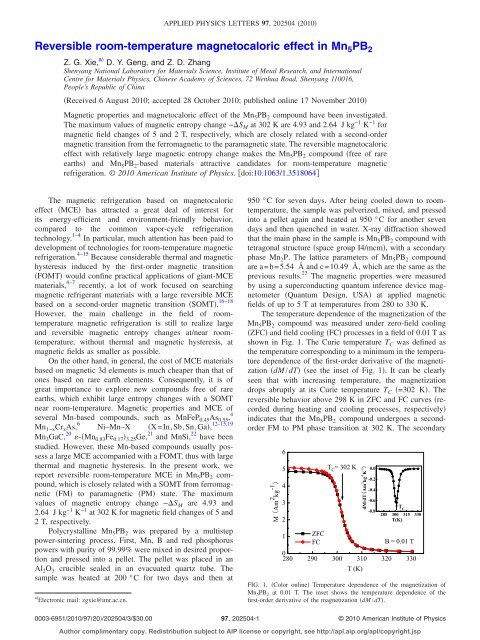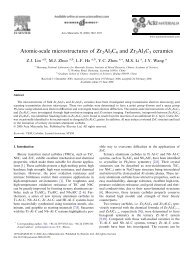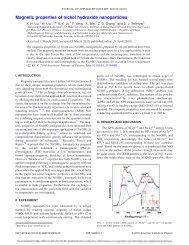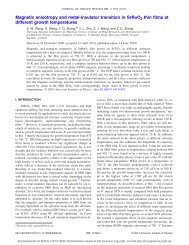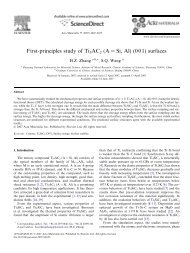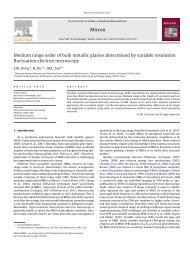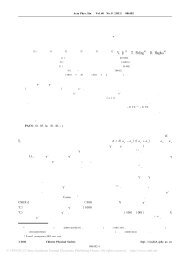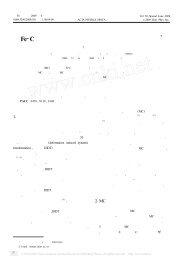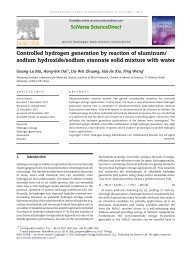Reversible room-temperature magnetocaloric effect in Mn5PB2
Reversible room-temperature magnetocaloric effect in Mn5PB2
Reversible room-temperature magnetocaloric effect in Mn5PB2
Create successful ePaper yourself
Turn your PDF publications into a flip-book with our unique Google optimized e-Paper software.
APPLIED PHYSICS LETTERS 97, 202504 2010<br />
<strong>Reversible</strong> <strong>room</strong>-<strong>temperature</strong> <strong>magnetocaloric</strong> <strong>effect</strong> <strong>in</strong> Mn 5 PB 2<br />
Z. G. Xie, a D. Y. Geng, and Z. D. Zhang<br />
Shenyang National Laboratory for Materials Science, Institute of Metal Research, and International<br />
Centre for Materials Physics, Ch<strong>in</strong>ese Academy of Sciences, 72 Wenhua Road, Shenyang 110016,<br />
People’s Republic of Ch<strong>in</strong>a<br />
Received 6 August 2010; accepted 28 October 2010; published onl<strong>in</strong>e 17 November 2010<br />
Magnetic properties and <strong>magnetocaloric</strong> <strong>effect</strong> of the Mn 5 PB 2 compound have been <strong>in</strong>vestigated.<br />
The maximum values of magnetic entropy change −S M at 302 K are 4.93 and 2.64 J kg −1 K −1 for<br />
magnetic field changes of 5 and 2 T, respectively, which are closely related with a second-order<br />
magnetic transition from the ferromagnetic to the paramagnetic state. The reversible <strong>magnetocaloric</strong><br />
<strong>effect</strong> with relatively large magnetic entropy change makes the Mn 5 PB 2 compound free of rare<br />
earths and Mn 5 PB 2 -based materials attractive candidates for <strong>room</strong>-<strong>temperature</strong> magnetic<br />
refrigeration. © 2010 American Institute of Physics. doi:10.1063/1.3518064<br />
The magnetic refrigeration based on <strong>magnetocaloric</strong><br />
<strong>effect</strong> MCE has attracted a great deal of <strong>in</strong>terest for<br />
its energy-efficient and environment-friendly behavior,<br />
compared to the common vapor-cycle refrigeration<br />
technology. 1–4 In particular, much attention has been paid to<br />
development of technologies for <strong>room</strong>-<strong>temperature</strong> magnetic<br />
refrigeration. 4–15 Because considerable thermal and magnetic<br />
hysteresis <strong>in</strong>duced by the first-order magnetic transition<br />
FOMT would conf<strong>in</strong>e practical applications of giant-MCE<br />
materials, 4–7 recently, a lot of work focused on search<strong>in</strong>g<br />
magnetic refrigerant materials with a large reversible MCE<br />
based on a second-order magnetic transition SOMT. 16–18<br />
However, the ma<strong>in</strong> challenge <strong>in</strong> the field of <strong>room</strong><strong>temperature</strong><br />
magnetic refrigeration is still to realize large<br />
and reversible magnetic entropy changes at/near <strong>room</strong><strong>temperature</strong>,<br />
without thermal and magnetic hysteresis, at<br />
magnetic fields as smaller as possible.<br />
On the other hand, <strong>in</strong> general, the cost of MCE materials<br />
based on magnetic 3d elements is much cheaper than that of<br />
ones based on rare earth elements. Consequently, it is of<br />
great importance to explore new compounds free of rare<br />
earths, which exhibit large entropy changes with a SOMT<br />
near <strong>room</strong>-<strong>temperature</strong>. Magnetic properties and MCE of<br />
several Mn-based compounds, such as MnFeP 0.45 As 0.55 , 4<br />
Mn 1−x Cr x As, 6 Ni–Mn–X X=In,Sb,Sn,Ga, 12–15,19<br />
Mn 3 GaC, 20 -Mn 0.83 Fe 0.17 3.25 Ge, 21 and MnSi, 22 have been<br />
studied. However, these Mn-based compounds usually possess<br />
a large MCE accompanied with a FOMT, thus with large<br />
thermal and magnetic hysteresis. In the present work, we<br />
report reversible <strong>room</strong>-<strong>temperature</strong> MCE <strong>in</strong> Mn 5 PB 2 compound,<br />
which is closely related with a SOMT from ferromagnetic<br />
FM to paramagnetic PM state. The maximum<br />
values of magnetic entropy change −S M are 4.93 and<br />
2.64 J kg −1 K −1 at 302 K for magnetic field changes of 5 and<br />
2 T, respectively.<br />
Polycrystall<strong>in</strong>e Mn 5 PB 2 was prepared by a multistep<br />
power-s<strong>in</strong>ter<strong>in</strong>g process. First, Mn, B and red phosphorus<br />
powers with purity of 99.99% were mixed <strong>in</strong> desired proportion<br />
and pressed <strong>in</strong>to a pellet. The pellet was placed <strong>in</strong> an<br />
Al 2 O 3 crucible sealed <strong>in</strong> an evacuated quartz tube. The<br />
sample was heated at 200 °C for two days and then at<br />
a Electronic mail: zgxie@imr.ac.cn.<br />
950 °C for seven days. After be<strong>in</strong>g cooled down to <strong>room</strong><strong>temperature</strong>,<br />
the sample was pulverized, mixed, and pressed<br />
<strong>in</strong>to a pellet aga<strong>in</strong> and heated at 950 °C for another seven<br />
days and then quenched <strong>in</strong> water. X-ray diffraction showed<br />
that the ma<strong>in</strong> phase <strong>in</strong> the sample is Mn 5 PB 2 compound with<br />
tetragonal structure space group I4/mcm, with a secondary<br />
phase Mn 2 P. The lattice parameters of Mn 5 PB 2 compound<br />
are a=b=5.54 Å and c=10.49 Å, which are the same as the<br />
previous results. 23 The magnetic properties were measured<br />
by us<strong>in</strong>g a superconduct<strong>in</strong>g quantum <strong>in</strong>ference device magnetometer<br />
Quantum Design, USA at applied magnetic<br />
fields of up to 5 T at <strong>temperature</strong>s from 280 to 330 K.<br />
The <strong>temperature</strong> dependence of the magnetization of the<br />
Mn 5 PB 2 compound was measured under zero-field cool<strong>in</strong>g<br />
ZFC and field cool<strong>in</strong>g FC processes <strong>in</strong> a field of 0.01 T as<br />
shown <strong>in</strong> Fig. 1. The Curie <strong>temperature</strong> T C was def<strong>in</strong>ed as<br />
the <strong>temperature</strong> correspond<strong>in</strong>g to a m<strong>in</strong>imum <strong>in</strong> the <strong>temperature</strong><br />
dependence of the first-order derivative of the magnetization<br />
dM/dT see the <strong>in</strong>set of Fig. 1. It can be clearly<br />
seen that with <strong>in</strong>creas<strong>in</strong>g <strong>temperature</strong>, the magnetization<br />
drops abruptly at its Curie <strong>temperature</strong> T C =302 K. The<br />
reversible behavior above 298 K <strong>in</strong> ZFC and FC curves recorded<br />
dur<strong>in</strong>g heat<strong>in</strong>g and cool<strong>in</strong>g processes, respectively<br />
<strong>in</strong>dicates that the Mn 5 PB 2 compound undergoes a secondorder<br />
FM to PM phase transition at 302 K. The secondary<br />
FIG. 1. Color onl<strong>in</strong>e Temperature dependence of the magnetization of<br />
Mn 5 PB 2 at 0.01 T. The <strong>in</strong>set shows the <strong>temperature</strong> dependence of the<br />
first-order derivative of the magnetization dM/dT.<br />
0003-6951/2010/9720/202504/3/$30.00<br />
97, 202504-1<br />
© 2010 American Institute of Physics<br />
Author complimentary copy. Redistribution subject to AIP license or copyright, see http://apl.aip.org/apl/copyright.jsp
202504-2 Xie, Geng, and Zhang Appl. Phys. Lett. 97, 202504 2010<br />
FIG. 2. Color onl<strong>in</strong>e Magnetic isotherms of Mn 5 PB 2 <strong>in</strong> the <strong>temperature</strong><br />
range of 280–324 K with <strong>temperature</strong> step of 4 K, measured with<br />
<strong>in</strong>creas<strong>in</strong>g-field solid squares and decreas<strong>in</strong>g-field solid triangles processes.<br />
Double arrows <strong>in</strong>dicate the reversible character of isothermal magnetization<br />
curves.<br />
phase Mn 2 P is antiferromagnetic below its Néel <strong>temperature</strong><br />
of 103 K, 24 so it has no contribution to magnetic properties<br />
of the sample above 103 K, but as a nonmagnetic impurity it<br />
will slightly lower the saturation magnetization.<br />
To explore the MCE of the Mn 5 PB 2 compound, the<br />
isothermal magnetization curves M −H <strong>in</strong> the vic<strong>in</strong>ity of<br />
Curie <strong>temperature</strong> are measured with a maximal field of 5 T<br />
and shown <strong>in</strong> Fig. 2. The solid squares denote the field<strong>in</strong>creas<strong>in</strong>g<br />
process, while the solid triangles correspond to<br />
the decreas<strong>in</strong>g-field process. The magnetization <strong>in</strong>creases<br />
rapidly at low fields and shows a tendency to saturate with an<br />
<strong>in</strong>crease of magnetic field but not saturated even at 5 T,<br />
which is typical for FM materials below its Curie <strong>temperature</strong>.<br />
The magnetization at 280 K is 57.89 A m 2 kg −1 at 5 T,<br />
which is comparable to the saturation magnetization of<br />
pure Ni. Moreover, no magnetic hysteresis between the<br />
<strong>in</strong>creas<strong>in</strong>g- and decreas<strong>in</strong>g-field curves is found around the<br />
transition <strong>temperature</strong>, <strong>in</strong>dicat<strong>in</strong>g that the FM-PM transition<br />
at T C is of second-order.<br />
Arrott plots M 2 versus B/M at different <strong>temperature</strong>s<br />
are shown <strong>in</strong> Fig. 3, <strong>in</strong> order to further confirm the type of<br />
the phase transition. It is known that the negative slopes<br />
S-shaped curves <strong>in</strong> the Arrott plots <strong>in</strong>dicate a first-order<br />
phase transition; otherwise, it is a second-order one. It is<br />
FIG. 3. Color onl<strong>in</strong>e Arrott plots of Mn 5 PB 2 from 280 to 324 K with the<br />
<strong>temperature</strong> step of 4 K.<br />
FIG. 4. Color onl<strong>in</strong>e Temperature dependences of the magnetic entropy<br />
changes −S M of Mn 5 PB 2 for magnetic field changes B of 2, 3, and 5 T.<br />
clear from the Arrott plots <strong>in</strong> Fig. 3 that there are no<br />
S-shaped curves near T C , <strong>in</strong>dicat<strong>in</strong>g the second-order nature<br />
of the FM-PM phase transition, which is consistent with the<br />
results obta<strong>in</strong>ed above from Figs. 1 and 2.<br />
The magnetic entropy changes −S M as a function of<br />
<strong>temperature</strong> and magnetic field for Mn 5 PB 2 are calculated<br />
from isothermal magnetization curves. By us<strong>in</strong>g the Maxwell<br />
relation S/B T =M /T B , the magnetic entropy changes<br />
can be calculated as follows:<br />
S M T,B = S M T,B − S M T,0<br />
B S M<br />
dB<br />
=0 B<br />
T<br />
B M dB.<br />
=0<br />
TB<br />
The <strong>temperature</strong> dependences of the magnetic entropy<br />
changes −S M of Mn 5 PB 2 for magnetic field changes of 2, 3,<br />
and 5 T are presented <strong>in</strong> Fig. 4. The maximum magnetic<br />
entropy changes −S max M occur at 302 K, which just corresponds<br />
to the FM to PM phase transition. The values of<br />
−S max M are 2.64, 3.51, and 4.93 J kg −1 K −1 for magnetic<br />
max<br />
field changes of 2, 3, and 5 T, respectively. The −S M<br />
reaches 4.93 J kg −1 K −1 for a magnetic field change of<br />
5 T, which is comparable to those of other potential<br />
Mn-based magnetic refrigerant materials with T C near<br />
<strong>room</strong>-<strong>temperature</strong>, such as MnFe 4 Si 3 4 J kg −1 K −1 , 25<br />
MnFe 0.15 Co 0.85 Ge 5.3 J kg −1 K −1 , 26 and Mn 5 Ge 2.9 Sb 0.1<br />
6.6 J kg −1 K −1 . 27 Though the value of −S max M at <strong>room</strong><strong>temperature</strong><br />
of Mn 5 PB 2 cannot be compared with the famous<br />
Mn-based refrigeration materials, MnFePAs compounds 4 and<br />
Ni–Mn-based Heusler alloys, 12–15,19 it should be emphasized<br />
that the MCE <strong>in</strong> the present compound is reversible without<br />
any thermal and magnetic hysteresis, associated with a<br />
SOMT. It is unsuitable to compare directly the −S M value<br />
of a material with a SOMT with that of a material with a<br />
FOMT. Furthermore, although the secondary phase Mn 2 P<br />
has no magnetic contribution near <strong>room</strong>-<strong>temperature</strong>, as<br />
mentioned above, it decreases the value of the saturation<br />
magnetization of the sample. If one succeeded <strong>in</strong> synthesiz<strong>in</strong>g<br />
the material of s<strong>in</strong>gle phase Mn 5 PB 2 , the saturation magnetization<br />
and the maximum magnetic entropy change would<br />
be enhanced. Moreover, it is expected that the substitution of<br />
3d elements for Mn may <strong>in</strong>crease the maximum magnetic<br />
entropy changes, specially, at low magnetic fields.<br />
Author complimentary copy. Redistribution subject to AIP license or copyright, see http://apl.aip.org/apl/copyright.jsp
202504-3 Xie, Geng, and Zhang Appl. Phys. Lett. 97, 202504 2010<br />
In conclusion, magnetic properties and MCE of the<br />
Mn 5 PB 2 compound have been studied. The relatively large<br />
reversible MCE with −S M max of 4.93 and 2.64 J kg −1 K −1<br />
are achieved at 302 K for magnetic field changes of 5 and 2<br />
T, respectively. The relatively large magnetic entropy change<br />
and the reversible MCE make the Mn 5 PB 2 compound free<br />
of rare earths a promis<strong>in</strong>g candidate material for <strong>room</strong><strong>temperature</strong><br />
magnetic refrigeration application. This work<br />
opens a new direction for search<strong>in</strong>g advanced <strong>room</strong><strong>temperature</strong><br />
magnetic refrigerants, Mn 5 PB 2 -based MCE materials.<br />
This work has been supported by the National Natural<br />
Science Foundation of Ch<strong>in</strong>a under Grant No. 50831006.<br />
1 E. Warburg, Ann. Phys. 13, 1411881.<br />
2 C. B. Zimm, A. Jastrab, A. Sternberg, V. K. Pecharsky, K. A.<br />
Gschneidner, Jr., M. Osborne, and I. Anderson, Adv. Cryog. Eng. 43,<br />
1759 1998.<br />
3 J. Glanz, Science 279, 2045 1998.<br />
4 O. Tegus, E. Brück, K. H. J. Buschow, and F. R. de Boer, Nature London<br />
415, 150 2002.<br />
5 N. K. Sun, W. B. Cui, D. Li, D. Y. Geng, F. Yang, and Z. D. Zhang, Appl.<br />
Phys. Lett. 92, 072504 2008.<br />
6 V. K. Pecharsky and K. A. Gschneidner, Jr., Phys. Rev. Lett. 78, 4494<br />
1997.<br />
7 V. Provenzano, A. J. Shapiro, and R. D. Shull, Nature London 429, 853<br />
2004.<br />
8 H. Wada and Y. Tanabe, Appl. Phys. Lett. 79, 3302 2001.<br />
9 Y. Sun, M. B. Salamon, and S. H. Chun, J. Appl. Phys. 92, 3235 2002.<br />
10 F.X.Hu,B.G.Shen,J.R.Sun,andG.H.Wu,Phys. Rev. B 64, 132412<br />
2001.<br />
11 O. Tegus, B. Fuquan, W. Dagula, L. Zhang, E. Brück, P. Z. Si, F. R. de<br />
Boer, and K. H. J. Buschow, J. Alloys Compd. 396, 62005.<br />
12 P. A. Bhobe, K. R. Priolkar, and A. K. Nigam, Appl. Phys. Lett. 91,<br />
242503 2007.<br />
13 S. Stadler, M. Khan, J. Mitchell, N. Ali, A. M. Gomes, I. Dubenko, A. Y.<br />
Takeuchi, and A. P. Guimarães, Appl. Phys. Lett. 88, 192511 2006.<br />
14 T. Krenke, E. Duman, M. Acet, E. F. Wassermann, X. Moya, L. Mañosa,<br />
and A. Planes, Nature Mater. 4, 4502005.<br />
15 L. Pareti, M. Solzi, F. Albert<strong>in</strong>i, and A. Paoluzi, Eur. Phys. J. B 32, 303<br />
2003.<br />
16 K. A. Gschneidner, Jr., V. K. Pecharsky, and A. O. Tsokol, Rep. Prog.<br />
Phys. 68, 1479 2005.<br />
17 B. Li, W. J. Hu, X. G. Liu, F. Yang, W. J. Ren, X. G. Zhao, and Z. D.<br />
Zhang, Appl. Phys. Lett. 92, 242508 2008.<br />
18 Q. Zhang, B. Li, X. G. Zhao, and Z. D. Zhang, J. Appl. Phys. 105, 053902<br />
2009.<br />
19 K. Oikawa, W. Ito, Y. Imano, Y. Sutou, R. Ka<strong>in</strong>uma, K. Ishida, S. Okamoto,<br />
O. Kitakami, and T. Kanomata, Appl. Phys. Lett. 88, 122507<br />
2006.<br />
20 M. H. Yu, L. H. Lewis, and A. R. Moodenbaugh, J. Appl. Phys. 93, 10128<br />
2003.<br />
21 J. Du, W. B. Cui, Q. Zhang, S. Ma, D. K. Xiong, and Z. D. Zhang, Appl.<br />
Phys. Lett. 90, 042510 2007.<br />
22 P. Arora, M. K. Chattopadhyay, and S. B. Roy, Appl. Phys. Lett. 91,<br />
062508 2007.<br />
23 O. Beckman and L. Lundgren, <strong>in</strong> Handbook of Magnetic Materials, edited<br />
by K. H. J. Buschow Elsevier, New York, 1991, Vol. 6, Chap. 3.<br />
24 M. Yessik, Philos. Mag. 17, 623 1968.<br />
25 D. Songl<strong>in</strong>, O. Tegus, E. Brück, J. C. P. Klaasse, F. R. de Boer, and K. H.<br />
J. Buschow, J. Alloys Compd. 334, 249 2002.<br />
26 S. L<strong>in</strong>, O. Tegus, E. Brück, W. Dagula, T. J. Gortenmulder, and K. H. J.<br />
Buschow, IEEE Trans. Magn. 42, 3776 2006.<br />
27 D. Songl<strong>in</strong>, O. Tegus, E. Brück, F. R. de Boer, and K. H. J. Buschow, J.<br />
Alloys Compd. 337, 269 2002.<br />
Author complimentary copy. Redistribution subject to AIP license or copyright, see http://apl.aip.org/apl/copyright.jsp


